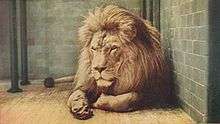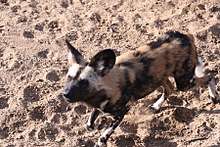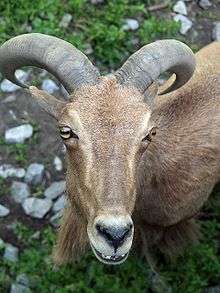Wildlife of Algeria
The wildlife of Algeria is composed of its flora and fauna. Mountainous, chotts, wetlands and grassy desert-like regions all support a wide range of wildlife. Many of the creatures comprising the Algerian wildlife live in close proximity to civilisation. The most commonly seen animals include the wild boars, jackals, and gazelles, although it is not uncommon to spot fennecs and jerboas. Leopard and cheetah are seldom seen.


A variety of bird species make the country an attraction for bird watchers. Barbary macaques are the sole native monkey. Snakes, monitor lizards, and numerous other reptiles can be found living among an array of rodents throughout the semi arid regions of Algeria.
Endangered species and conservation
Algeria is also home to a number of dangered species which are currently not protected under Algerian law.
A creature that is dangered in Algeria is the Mediterranean monk seal. These seals live in caves and in rocky outcrops along the coast of Algeria and their numbers have been made scarce by over-fishing and pollution. Monk seals do not give birth often and usually have only one pup, which means attempts to increase the seal population are slow and difficult. Besides the serval and seals, Algerian wild dogs and a species of bat are also considered to be endangered.
Flowers
In the north some of the native flowers includes daffodiles scrub, oaks, cedars and other conifers.[2] The grape vine is indigenous to the coast. In the Sahara region some oases have palm trees. Acacias with wild olives are the predominant flowers in the remainder of the Sahara.
Fauna
Mammals
There are 104 mammal species in Algeria, of which three are critically endangered, two are endangered, ten are vulnerable, and three are near-threatened. One of the species listed for Algeria is extinct and one can no longer be found in the wild.
Reptiles, fish, amphibians, birds and mammals
- Chalcides mauritanicus
- Chalcides minutus
- Boomslang
- Horned desert viper
- Cerastes vipera
- Saw-scaled viper
- European turtle dove
- Saharan spiny-tailed lizard
- Desert monitor
- Gongylophis muelleri
- Guinea fowl
- Egyptian cobra
- Mediterranean chameleon
- Testudo graeca
- Gongylophis colubrinus
- Erycinae
- European pond terrapin
- Small-spotted lizard
- Sahara frog
- Eurasian wryneck
- Little grebe
- Great crested grebe
- Great spotted woodpecker
- Black stork
- White stork
- Griffon vulture
- Rough-toothed dolphin
- Atlantic spotted dolphin
- Common dolphin
- Pygmy killer whale
- Orca
- Pilot whale
- Starling
- European green toad
- Brine shrimp
- Mediterranean tree frog
- Common toad
- European pond terrapin
- Mediterranean house gecko
- Moorish gecko
- Red-tailed spiny-footed lizard
- Iberian wall lizard
- Algerian sand racer
- Southern smooth snake
- False smooth snake
- Natrix maura
- Lataste's viper
- Nile crocodile but extinct in the wild
- North African ostrich
- Egyptian vulture
- Golden eagle
- Bonelli's eagle
- Loons
- Grebes
- Shearwaters
- Petrels
- Storm-petrels
- Pelicans
- Gannets
- Cormorant
- Bitterns
- Herons
- Egrets
- Storks
- Ibises
- Spoonbills
- Flamingos
- Ducks
- Geese
- Swans
- Osprey
- Hawks
- Kites
- Eagles
- Caracaras
- Falcon
- Pheasant
- Partridge
- Buttonquail
- Crane
- Rails
- Crakes
- Coots
- Ardeotis arabs
- Oystercatchers
- Avocet
- Stilt
- Thick-knee
- Pratincole
- Courser
- Plover
- Lapwing
- Sandpiper
- Skuas
- Jaegers
- Gulls
- Terns
- Auks
- Murres
- Puffins
- Sandgrouse
- Pigeons
- Doves
- Cuckoos
- Ani
- Barn owls
- Typical owls
- Nightjars
- Swifts
- Kingfishers
- Bee-eaters
- Great white shark
- Grey nurse shark
- Great hammerhead
- Basking shark
- Shortfin mako
- Atlantic bluefin tuna
- Atlantic blue marlin
- Atlantic white marlin
- Loggerhead sea turtle
- Porbeagle
- Blacktip shark
- Spinner shark
- Dusky shark
- Common octopus
- Bignose shark
- Sandbar shark
- Blacktip reef shark
- Great white shark
- Scalloped hammerhead
- Sharpnose sevengill shark
- Bluntnose sixgill shark
- Gulper shark
- Kitefin shark
- Bramble shark
- Velvet belly lantern shark
- Angular roughshark
- Perez's frog
- Leatherback turtle
- Brongersma's toad
- European eel
- Salamandra algira
- Acanthodactylus
- Bedriaga's fringe-fingered lizard
- Algerian ribbed newt
- Edough ribbed newt
- Caracal caracal algira
Insects
- Epimyrma africana
- Monomorium noualhieri
- Epimyrma algeriana
- Strongylognathus afer
- Strongylognathus foreli
- Red locust
- Desert locust
- Fat-tailed scorpion
- Honey bee
- Acilius duvergeri
- Calopteryx exul
- Chalepoxenus brunneus
- Myrmica pharaonis
- Onychogomphus costae
- Strongylognathus afer
Prehistoric period
Prehistoric mammals
- Moeritherium
- Pelorovis
- Megantereon
- Homotherium
- Protocetus
- Hipparion
- Sivatherium
- Prolibytherium
- Propliopithecus
- Dryopithecus
- Sivapithecus
- Ramapithecus
- Dinofelis
- Kanuites
- Ictitherium
- Agriotherium
- Ursus etruscus
- Indarctos
- Ursavus
- Anancus
- Archaeobelodon
- Platybelodon
- Palaeomastodon
- Barytherium
- Deinotherium
- Dorudon
- Basilosaurus
- Samotherium
- Stegodon
- Hyaenodon
- Gomphotherium
- Albanosmilus
- Barbourofelis
- Ginsburgsmilus
- Prosansanosmilus
- Sansanosmilus
- Machairodus
- Miomachairodus
- Therailurus
Dinosaurs
Prehistoric reptiles
References
- Black, S. A.; Fellous, A.; Yamaguchi, N.; Roberts, D. L. (2013). "Examining the Extinction of the Barbary Lion and Its Implications for Felid Conservation". PLOS One. 8 (4): e60174. doi:10.1371/journal.pone.0060174. PMC 3616087. PMID 23573239.
- National Audubon Society (2009). Field Guide to African Wildlife. New York: Alfred A. Knopf. pp. 43–44. ISBN 0-679-43234-5.

